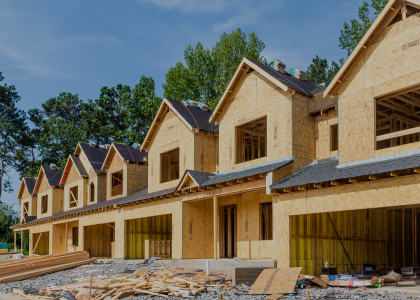A new survey of 1,500 U.S. homeowners provides insights on which packages of home energy upgrades are most appealing, who is most open to them, and which messages work best to encourage action.
With America’s aging housing stock and the increasing urgency of climate change, comprehensive energy retrofits are more important than ever. These renovations—designed to achieve at least a 20% reduction in household energy consumption—deliver substantially higher energy savings, bill savings and health benefits compared to smaller individual energy efficiency improvements. But comprehensive retrofits can also be expensive, so state energy offices, utilities and those that run their energy efficiency programs need to maximize offerings to get comprehensive upgrades into as many homes as possible.
Register for the Report Release Webinar today, April 1, at 2:00pm ET
One way to tackle these barriers is to target the homeowners who are most likely to invest, presenting upgrade packages they want, using the right messages and applying behavioral science-based strategies. ACEEE’s new report—based on a first-of-its-kind survey—explains how. When it comes to encouraging comprehensive upgrades, there are four things to consider: the audience, the messages, the strategies, and the packages.
The audience
Although they provide many benefits, comprehensive home energy retrofits are expensive. This puts them out of reach for low-income residents. Initiatives like the Weatherization Assistance Program and provisions from the Inflation Reduction Act will help, but bringing energy efficiency to underserved households will require even greater investments. Among homeowners, we found the most likely to invest earn at least moderate incomes (household income above $50,000 a year), are more educated (undergraduate degree or higher), live in large homes (2,001-2,500 square feet), have lived in their homes for 6-10 years with no children at home, and either own, owned, or are considering owning an EV. Efficiency programs will be most effective at encouraging comprehensive retrofits if they focus on these homeowners first.
The message
Energy upgrade messages should focus on the availability of rebates and tax incentives that lower installation costs for homeowners (when available) and highlight potential bill savings, home comfort and health benefits. Homeowners in our study rated cost, bill savings, comfort, and health as the strongest drivers of their upgrade decisions (on average, rating them “important” to “very important”).
The strategies
Our data suggest, not surprisingly, that providing no-interest loans with $0 down can significantly shift homeowners toward investing in comprehensive upgrades more than rebates and tax credits alone. Targeting marketing of these initiatives toward homeowners who recently bought a house or need to replace old equipment will also significantly increase the likelihood of investing. One behavioral-science based strategy that could work (but needs additional testing) is creating comprehensive packages with homeowners using step-by step additions of energy-conserving upgrades one at a time. This approach involves offering additional upgrades to improve comfort and savings to homeowners who already agreed to one upgrade (sometimes called the “foot-in-the-door” approach).
The packages
We found that packages centering on upgrading home heating, hot water heating, and appliances were most popular among homeowners. When asked for their preference among different options, these items significantly increased the appeal of packages (by 5%-22% each). When contractors go into the field, they should listen to homeowners and customize based on what they hear, but before knowing the preferences of specific customers, generic packages should include these three elements. We also identified six types of homeowners who are willing to invest in six different packages of upgrades. These are:
1. I want appliance upgrades and not solar (28% of Interested Homeowners)
This group of homeowners selected packages that included appliance upgrades and stayed away from packages including rooftop solar. People in this group tend to be older, be of lower to middle income brackets (but not the lowest annual income brackets under $20,000), live in attached housing (duplex or row house), and have lived in their home between 5 and 15 years.
2. Upgrade My Heating, Cooling and Hot Water… and Maybe Some Other Things Too (26% of Interested Homeowners)
This cautiously interested group of upgraders tends to select packages that include upgrades to hot water heaters and heating/cooling systems. Sometimes, they also would not mind other upgrades, such as solar and EV charging, but they are not strongly moved (positively or negatively) by windows, insulation, or appliance upgrades. People in this group tended to be female, more likely to have small family sizes with fewer children at home and less likely to be in low-income brackets.
3. Give Me Energy Independence: Solar, EV charger, and Energy Efficiency (17% of Interested Homeowners)
This group is interested in all energy upgrades other than windows and is particularly strongly motivated to buy packages that include solar. People in this group are likely to be female and have plans to purchase an electric vehicle. This group is in both low-income brackets (annual incomes below $50,000) and the highest income bracket (above $200,000) and live in both the smallest houses or apartments (under 1,000 square feet) and the largest homes (over 3,500 square feet).
4. Reduce My Energy Consumption to the Max: Traditional Comprehensive Energy Efficiency (17% of Interested Homeowners)
This group is interested in energy efficiency upgrades of all types but not in rooftop solar or Level 2 EV charging (EV home charging at 240V – faster than using a standard outlet). People in this group are more likely to be male, older, have incomes less than $200,000, live in larger single family detached homes (mostly over 1,500 square feet, with many over 2,500 square feet), and have larger families than other groups.
5. Upgrade My Heating, Cooling and Hot Water… and That’s All (12% of Interested Homeowners)
This group of homeowners are best characterized by their active avoidance of packages with solar and Level 2 EV charging. The only package elements that they are drawn to are efficient heating and cooling and hot water heater upgrades. People in this group are likely female, have incomes between $150,000 and $200,000, and living in duplexes, rowhouses, condominium buildings, or manufactured/mobile homes.
What we asked and who we surveyed
This report is based on a survey of a nationally representative sample of homeowners from across the United States (1,500 respondents). Homeowners chose their preferred packages of upgrades from six sets of two (i.e., they completed a discrete choice experiment with six choice sets of two options each). This revealed which upgrade package elements were most appealing. They also completed several additional experiments that examined responses to hypothetical scenarios testing message framing, financing, and behavior-based strategies to encourage upgrades. The survey ended with a suite of demographic, geographic, general motivation, and home characteristic questions that were used to segment the population and identify what drove them to upgrade (or not).
Home energy retrofits are important, so efficiency programs must be persuasive
Encouraging comprehensive home upgrades is critically important. To maximize the impact of state-run and utility-run energy efficiency programs and increase comprehensive retrofits, those administering energy efficiency programs need to offer packages people want, to the people who are most likely to purchase them, using the right messaging. This new ACEEE report will help guide these efforts.








